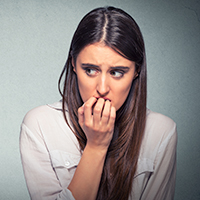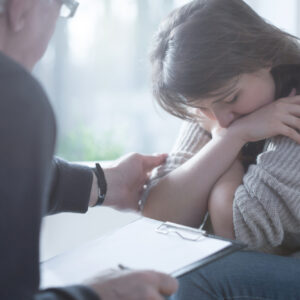Anxiety[i] is a fear-based mental and physical state that commonly occurs in both adults and children. For most people, anxious feelings are an unpleasant but harmless fact of life. However, in some people, these feelings reach a level of intensity that interferes with the ability to feel safe, experience a sense of well-being or carry out an effective daily routine, resulting in anxiety disorder. A brief rundown will help explain the differences between everyday anxiety and the symptoms of medically serious anxiety disorders.
Why Does Anxiety Exist?
 Anxiety is hardwired into the basic human pattern of emotional responses. Over the course of the human history, anxiety has served as part of the innate “fight-or-flight” reflex, which activates automatically in situations perceived as unpleasant, dangerous or life-threatening. By magnifying a sense of discomfort, anxious feelings increase awareness of any changes in one’s immediate surroundings, often manifesting in physical symptoms. They also help prepare the body for a rapid response that could make the difference between survival and death in the midst of intense fear.
Anxiety is hardwired into the basic human pattern of emotional responses. Over the course of the human history, anxiety has served as part of the innate “fight-or-flight” reflex, which activates automatically in situations perceived as unpleasant, dangerous or life-threatening. By magnifying a sense of discomfort, anxious feelings increase awareness of any changes in one’s immediate surroundings, often manifesting in physical symptoms. They also help prepare the body for a rapid response that could make the difference between survival and death in the midst of intense fear.
Anxiety in the Modern World
Despite ongoing advances in science and technology, human beings still rely on the same fight-or-flight responses that developed in much simpler times. This reliance can lead to problems for one basic reason. Namely, in today’s crowded and fast-paced world, the average person has a good chance of encountering anxiety-inducing situations on a more or less regular basis. Most people can cope with this increased exposure to anxiety without suffering any serious harm or long-term anxiety symptoms. However, some cannot.
Signs of Commonplace Anxiety
Commonplace or occasional anxiety does not have a lasting negative impact. It can take a range of forms, including:
- Feeling self-conscious or embarrassed in situations that break social norms
- Reacting to a legitimate threat to health or well-being
- Feeling nervous before taking part in an important personal or social event
- Worrying about money troubles
- Worrying about relationships
- Worrying about getting a job
- Worrying about changes in the workplace
- Feeling upset in the aftermath of some form of trauma exposure
General Indicators of Anxiety Disorders
Anxiety disorder[ii] is the term used to describe any pattern of anxiety-based reactions that causes lasting harm, such as panic attacks, intense fear, physical illness, difficulty concentrating, muscle tension, and irritable bowel syndrome. These reactions typically occur in situations that don’t seem threatening to the average person. In addition, they:
- Seem excessive or irrational to outside observers
- Occur frequently or persistently
- Are not under the conscious control of those who are affected
Signs and Symptoms of Specific Anxiety Disorders
 The Anxiety and Depression Association of America reports that roughly 40 million U.S. adults have a diagnosable anxiety disorder. When affected children are included, these conditions rank as the country’s most common mental health problems. Examples of the anxiety disorders and illnesses recognized by the American Psychiatric Association include:
The Anxiety and Depression Association of America reports that roughly 40 million U.S. adults have a diagnosable anxiety disorder. When affected children are included, these conditions rank as the country’s most common mental health problems. Examples of the anxiety disorders and illnesses recognized by the American Psychiatric Association include:
- Generalized anxiety disorder
- Panic attacks/panic disorder
- Social phobia (i.e., social anxiety disorder)
- Separation anxiety disorder
- Agoraphobia
- Specific phobia
- Anxiety disorder due to another medical condition
- Substance/medication-induced anxiety disorder
Each of these mental health disorders and conditions has its specific signs and symptoms. For example, indicators for social anxiety disorder include:
- Extreme self-consciousness in everyday social situations
- Extreme fear of embarrassment, rejection, judgment or humiliation in social situations
- Extreme anxiousness in situations that require social interaction
- Avoidance of places where social interactions are likely to occur
- A long buildup of anxiousness or fear before an upcoming social event
- Distressing physical changes (i.e., nausea, muscle tremors, excessive sweating, blushing) in social situations
- Difficulty establishing or maintaining friendships
Generalized anxiety disorder symptoms include:
- Persistent, non-specific feelings of worry or anxiousness
- An inability to keep feelings of worry or anxiousness under control
- Frequent sleep disruptions or an inability to sleep soundly
- A poor ability to concentrate or focus attention
- Poor physical stamina
- Mental agitation or irritability
- Unusually tense muscles
Potential indicators of a single panic attack include:
- Sudden, unpredictable feelings of extreme fear
- Distressing changes in normal heart function (e.g., a rapid heartbeat, heart palpitations)
- Distressing changes in normal breathing (e.g., a choking or smothering sensation, an inability to catch a full breath)
- An illogical feeling of rapidly approaching disaster
People with panic disorder have recurring panic attacks. In addition, they may:
- Spend significant amounts of time worrying about the possibility of a new attack
- Stay away from places where previous bouts of panic occurred
- Feel distressed about their inability to control their panic symptoms
People with agoraphobia[iii] experience panic in situations or locations where they feel hemmed in or unable to escape. This means symptoms can arise in confined spaces, as well as in open areas such as malls or parking lots. People with other types of specific phobias also feel panicked when confronted with certain kinds of locations, situations or events.
Anxiety Disorder Treatment
 Mental health experts and researchers have developed a variety of effective treatments for anxiety disorders. Anti-anxiety medications are sometimes used to control symptoms. However, longer-term control and resolution of those symptoms often call for the use of some form of counseling or therapy.
Mental health experts and researchers have developed a variety of effective treatments for anxiety disorders. Anti-anxiety medications are sometimes used to control symptoms. However, longer-term control and resolution of those symptoms often call for the use of some form of counseling or therapy.
One of the chief forms of therapeutic treatment for anxiety disorders is known as CBT or cognitive behavioral therapy. CBT focuses on two main goals:
- Understanding and counteracting the thoughts that support anxious states of mind
- Using gradual exposure to triggering situations/events as a method of increasing control and reducing anxiety levels
People in treatment for anxiety disorders also often benefit from stress management courses and stress-reducing activities such as tai chi, music therapy and meditation. In addition, many people aid their recovery by joining an anxiety-related support group.
Anxiety Disorders and Addiction Treatment
About one out of every five people diagnosed with an anxiety disorder also has a problem with drugs or alcohol[iv]. This means that anxiety treatment is often intertwined with substance use treatment. The presence of substance use disorders can make it more difficult to treat anxiety disorders. Conversely, the presence of an anxiety disorder can make it more difficult to treat substance problems.
At Transformations Treatment Center, we understand the impact that anxiety and anxiety disorders can have on substance treatment. Our individualized drug and alcohol programs account for this impact and help make sure that each client receives certified care that provides the best chance for attaining long-term health and stability. If you suffer from any type of anxiety disorder and substance abuse, contact us today to start healing and facing everyday situations free from the symptoms of anxiety.
[i] Anxiety and Depression Association of America: Understand the Facts
https://adaa.org/understanding-anxiety
[ii] National Institute of Mental Health: Anxiety Disorders
https://www.nimh.nih.gov/health/topics/anxiety-disorders/index.shtml
[iii] Mayo Clinic: Agoraphobia
https://www.mayoclinic.org/diseases-conditions/agoraphobia/symptoms-causes/syc-20355987
[iv] Anxiety and Depression Association of America: Substance Use Disorders
https://adaa.org/understanding-anxiety/related-illnesses/substance-abuse




